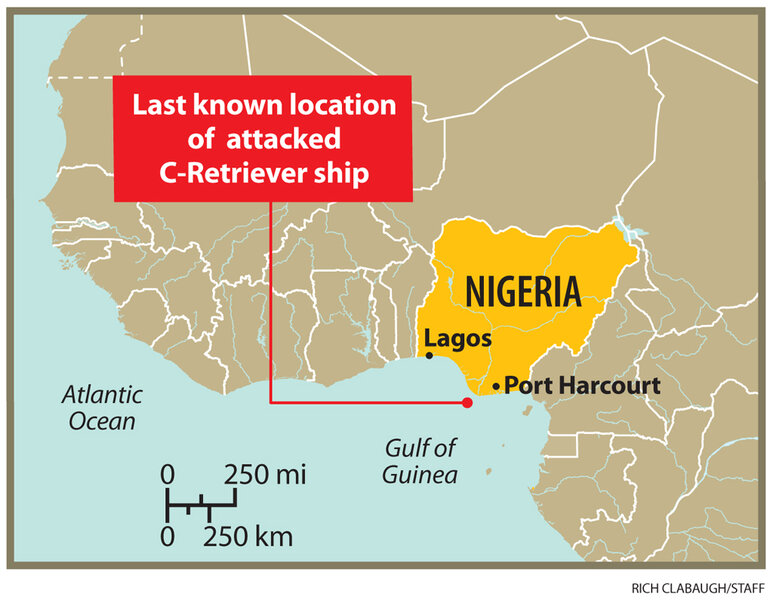US merchant seamen captured off Nigeria: the newest threat in piracy
Loading...
Two American merchant seamen have been captured by pirates off the coast of Nigeria in the Gulf of Guinea – an area that has seen an increased threat of piracy.
At this point, information is sketchy about the pirates, their motive, and any possible military or other response by the United States or other countries.
“We are closely monitoring reports that two US citizens have been kidnapped from a US-flagged vessel, the C-Retriever, in the Gulf of Guinea,” the US State Department said in a statement. “We are seeking additional information about the incident.”
The C-Retriever is a 222-foot oil platform supply vessel owned by the company Edison Chouest Offshore in Louisiana. The ship’s captain and its chief engineer were abducted. The vessel and 11 other members of the crew were released, a US defense official told the Associated Press.
In recent years, concern about piracy has centered off the coast of Somalia. As of Sept. 30, 2013, suspected Somali pirates were holding for ransom two vessels with 15 crewmembers on board, according to ICC Commercial Crime Services (CCS), the anticrime arm of the International Chamber of Commerce based in Britain. In addition, 49 kidnapped crewmembers are held on land, 37 of whom have been held for more than two years.
More generally, piracy on the world’s seas is at its lowest third-quarter level since 2006, according to the International Maritime Bureau (IMB). The latest IMB Piracy Report, published Oct. 17, shows 188 piracy incidents in the first nine months of 2013, down from 233 for the same period last year. Hostage-taking has also fallen markedly, with 266 people taken hostage this year, compared with 458 in the first three quarters of 2012.
But with fewer attacks off Somalia, attention has moved to the Gulf of Guinea, a hot spot for violent piracy and ship hijacking for many years, reports the CCS.
“The region recorded more than 40 piracy attacks in the first three quarters of 2013, with 132 crew taken hostage and seven vessels hijacked – six tankers and an offshore supply vessel,” the CCS reported last week. “The Gulf of Guinea accounted for all crew kidnappings worldwide, 32 of them off Nigeria, and two off Togo.”
“Nigeria, the main source of piracy in the region, accounted for 29 piracy incidents, including two hijackings, 11 ships boarded, 13 vessels fired upon, and three attempted attacks,” reports the CCS. “Pirates, often heavily armed and violent, are targeting vessels and their crews along the coast, rivers, anchorages, ports and surrounding waters. In many cases, they ransack the vessels and steal the cargo, usually gas and oil.”
Unlike the waters off Somalia and the Horn of Africa on the east coast of Africa, through which ships now speed with armed guards on board, many vessels have to anchor to do business off West African countries, with little protection, Reuters reports. This makes them a target for criminals and jacks up insurance costs. Kidnapped sailors and oil workers taken in Nigerian waters are usually released after a ransom is paid.
The Danish firm Risk Intelligence reports that pirate networks in the Gulf of Guinea focusing on tankers is a relatively new type of crime that has evolved into a unique and lucrative form of maritime crime in the region. In the first eight months of 2013, some 19 attacks took place against vessels operating in the region. There were 25 such attacks in 2012.
“This form of piracy has become very costly,” Risk Intelligence reported earlier this month. “An estimated 117,000 metric tons of product worth approximately $100 million has been stolen since 2010. The human cost of the pirate attacks is also significant. Two crew members on product tankers have been killed and at least 34 have been injured in hijacking related incidents.”
When Richard Phillips, captain of the MV Maersk Alabama, was taken hostage in 2009, US Navy SEALs were able to kill three of the pirates and capture the fourth, who is now serving a sentence of 33 years, 9 months. (The recent movie version, “Captain Phillips,” stars Tom Hanks in the title role.)
A Lagos-based official with the private security firm AKE, citing recent attack patterns, told the French news agency Agence France-Presse (AFP) that the raid on the C-Retriever was probably carried out by gunmen on board two or three speed boats, with four attackers on board each boat.
Nigeria does not allow vessels operating in its waters to have private armed security agents on board, according to the AFP report. Companies seeking armed protection against pirates must arrange to carry Nigerian naval personnel, a difficult and often unreliable process.
The closest military vessel is a Dutch Navy ship in the Gulf of Guinea with 90 US Marines aboard as part of an Africa training mission.
If a ransom is being negotiated between the pirates and owners of the C-Retriever, it likely would not be made public – at least until the ship’s captain and chief engineer had been released.








